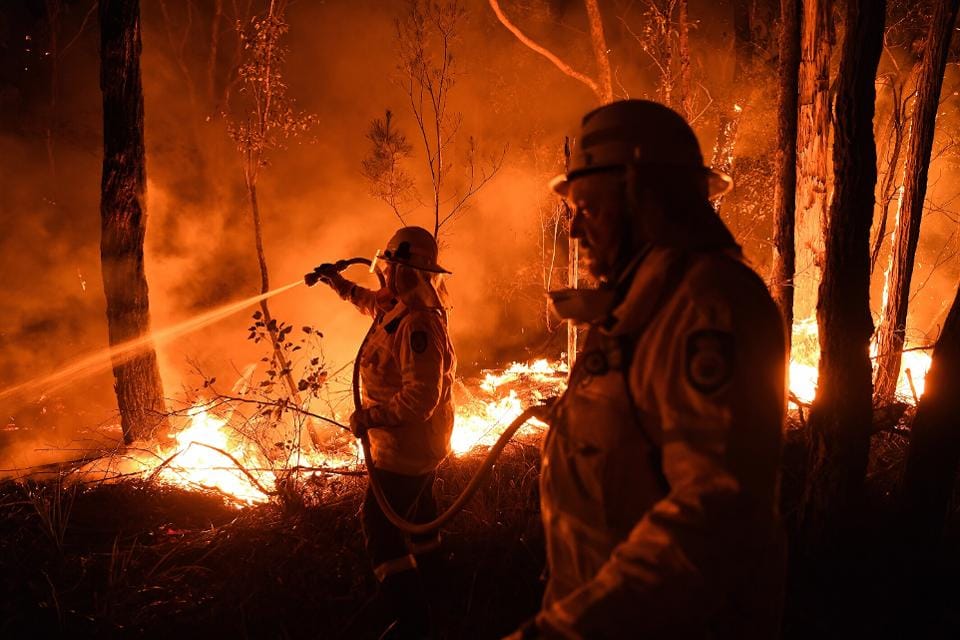Devastation sweeps Australia

 The continent of Australia is currently being ravaged by the deadliest and worst wildfires in a decade, with huge swaths of forest destroyed since the fire season started in late July. Primarily affecting homes in New South Wales, the fires have destroyed over 1,500 homes in Australia and burned 7.3 million hectares. The fires also affected major cities such as Sydney and Melbourne, where the smoke has gotten so thick that the air quality in Sydney measured 11 times the “‘hazardous” amount.
The continent of Australia is currently being ravaged by the deadliest and worst wildfires in a decade, with huge swaths of forest destroyed since the fire season started in late July. Primarily affecting homes in New South Wales, the fires have destroyed over 1,500 homes in Australia and burned 7.3 million hectares. The fires also affected major cities such as Sydney and Melbourne, where the smoke has gotten so thick that the air quality in Sydney measured 11 times the “‘hazardous” amount.
Australia, which is only two million kilometers squared smaller than the United States, has always had a dry season – the 2009 Black Saturday fires killed 173 people in Victoria, making it then the deadliest bushfire disaster on record. However, this year has been unusually dry, and the country’s Bureau of Meteorology said in December that last spring was the driest on record. Just one month ago, a heatwave in December broke the record for the highest recorded temperature ever in Australia (about 120 degrees Fahrenheit). Many are blaming Australian Prime Minister Scott Morrison for not listening to climate change activists and high-ranking emergency service officials about the increasing impact of climate change in Australia.
As of Jan. 9, 7.3 million hectares of land has burned – roughly the size of Ireland. New South Wales (NSW) has suffered nearly five million hectares of this damage, making it the worst-affected state in Australia. A total of 27 people have died in the fires this year, including several volunteer firefighters. In NSW alone, over 2,000 volunteer firefighters are on the ground with reinforcements from the US, Canada, and New Zealand on the way. The Australian Defense Force is assisting from the sky and over 70,000 volunteer firefighters have signed up to battle the flames. Smoke from the fires has also traveled 1,200 miles to New Zealand, where it turned the sky orange and melted nearby glaciers. Additionally, experts estimate that over one billion animals have died at this point, including a third of NSW’s population of koalas. However, researchers say they have no way of surveying just how extensive the damage is until the fires are out.
These fires are almost always started by natural causes, like lightning strikes in drought-stricken forests, such as this one, which traveled 12 miles in just five hours in the state of Victoria. However, 24 people have been charged with deliberately starting bushfires and 183 more have had legal action for fire-related charges taken against them since November. Experts say that climate change has worsened the scope and impact of natural disasters, with weather conditions growing more extreme every year and fire season starting earlier and earlier.
Tragically, Australia is only in the beginning of its summer, which means fire season is expected to last until roughly mid-March, with temperatures peaking around February. However, there are several organizations working toward victim relief, search and rescue, and helping the devastated animal population. Charities such as the Australian Red Cross, the Salvation Army Australia, and the NSW Rural Fire Service are asking for donations. Animal relief organizations like WIRES, the Port Macquarie Koala Hospital, and Currumbin Wildlife Hospital are also asking for donations and contributions to help save the millions of wounded and severely injured animals.
Below are links for organizations to which you can donate in order to help them to save lives in Australia:




